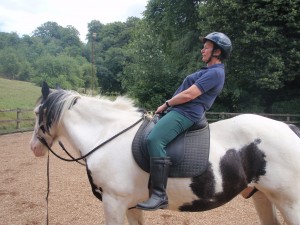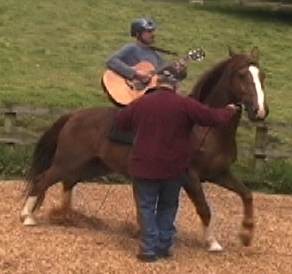Seat Training
“During the lesson, keep the horse between you and the ground at all times!”
It’s really true that without a perfect seat, you can’t deliver perfect aids. Yet there is so much opinion and controversy about what the rider should do with their body when riding. Imagine being proficient in a method that’s guaranteed to improve your suppleness, confidence, co-ordination, “stickability”, balance and capacity to think and act competently in a moment of stress.
There are two major aspects to “the seat”- the rider’s “position”, and their movement, which together to allow the horse to perform to the best of his ability. Both are addressed very effectively by seat training. You will know in a kinaesthetic, rather than image-based or academic sense, what you are after, and feel far more secure aboard any horse, as well as being able to apply the aids more clearly and intelligibly.
Suitable for anyone, at any stage in their riding, seat training is a fun and highly effective way to make rapid improvements to your riding (or teaching). Based on old-fashioned exercises on the lunge, but expanded and with more specific and targeted exercises, it works on the rider’s balance, alignment, stability, fluidity, suppleness, body control,confidence, co-ordination, and ability to process lots of information, all at once! In addition it trains the horse to accept movements from the rider that many horses would consider scary. Needless to say, then, it is incredibly efficient in terms of results per minute.
We have found it extremely valuable in improving our own riding skills. Check out this picture of Adam mucking about with our instructor Craig Stevens, to see how effective it is for improving riders’ capacity to stay a volatile horse. Look at the ****YOUTUBE CLIP**** to see if he survives.
NB Proficiency in the guitar is not a requirement!
If you are getting a bit frustrated with your riding, or feel you’ve hit a bit of a plateau, it’s helpful to get you back on track. If you haven’t been able to ride as much as you would like, you’ll find it the best preparation for attending a clinic, a competition, or getting on a new, young or difficult horse. It usually involves a lot of laughter, and once a few basic skills are mastered, it’s something a partner, parent, child or friend could do with you, without the arguments that usually ensue when familiar couples try to teach each other!
Horses tend to be remarkably tolerant of the process, too, and generally any horse that is happy with being ridden should be able to be successfully introduced to seat training (we do not recommend inexperienced persons to try this). If a horse is very worried about a rider moving around on board, making you obliged to sit very still and quietly, they may not appear to be an obvious candidate. On the other hand, the horse who has anxieties over this is not a safe ride, and we have found that the process of carefully and gradually introducing the horse to the exercises has helped them to calm down enormously. They learn that whatever sneezing, jacket removal, mobile phone ringtone or banging about the rider might do, they are not trying to murder the horse, and they can just ignore it- we’re not trying to ask him to respond to this at all. So, as well as improving many aspects of a rider’s skill, it also makes a huge impact on the horse’s confidence, and improves his balance and capability to be ridden by less than perfect riders. Which makes it double the value.
We frequently include some seat training as part of our riding clinics or everyday lessons. However, this work is so valuable that we have now begun (occasionally, as it is not always easy to assemble enough bodies to make it worth while- please email if you are interested) to schedule specific clinics explicitly on seat training. On these clinics, as in any normal lesson we have some very safe, experienced horses that we use for seat training, and for many people this is the obvious place to start. However, if you would like to bring and use your own horse, so that you can safely continue after the course, the Friday before each clinic is available to start this process. Otherwise, the clinics run as a weekend, with two seat-training sessions per day, and with everyone being involved in the lunging and command calling. Sessions may include work on a barrel, gym balls, and our new toy “Electra”, aka the iJoyride, an electric riding simulator which is also good for presenting challenges to the rider’s framework and stability.
The cost of the clinic is the same as our usual clinics, and is included in our unique discount scheme (UP TO 30% OFF!). The Friday work is charged at an hourly rate, presently £44. See clinic dates and book in the calendar.
By the end of a weekend, we expect you will be capable of doing five basic exercises accurately in walk and trot, but more importantly, you will be capable of taking this work home with you and further improving your own riding, either by yourself or with the help of almost anyone, no matter how little they may know about riding instruction. When you feel ready, we can advance to more challenging exercises, including in canter.
The best results come to those who seat train regularly and thoroughly. Therefore we recommend that people come in pairs or small groups with a horse if they can, and that they learn to instruct each other- which is not very difficult- and they then will be able to go home, consolidate the work they have begun with us, and come back for the next chunk a few weeks or months later. After a few sessions we would hope to have you training as a group, which is great fun.
By the time you have become confident to clap your feet together above a horse’s mane in canter, not much that a horse can throw at you will faze you any more! This work is a must for the less confident rider. Your riding will take a quantum leap in a few sessions.
Group Seat Training lessons are also regularly available on a Saturday morning. Please email or check the CALENDAR for dates.








